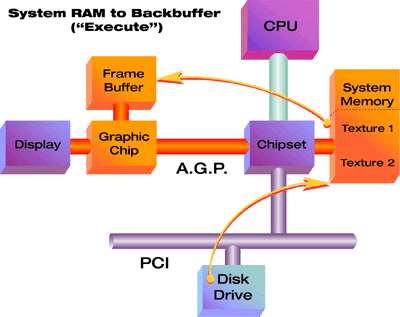|
|
|
|
|
|
|
|
|
|
Chapter 2: 3D Graphics on Next Generation PCs The addition of AGP is, of course, the other key enhancement to the PC platform that benefits 3D graphics. AGP relieves the graphics bottleneck by adding a new dedicated high-speed bus directly between the chipset and the graphics controller. This removes bandwidth-intensive 3D and video traffic from the constraints of the PCI bus. In addition, AGP allows textures to be accessed directly from system memory during rendering rather than being pre-fetched to local graphics memory. Segments of system memory can be dynamically reserved by the OS for use by the graphics controller; this memory is termed AGP memory or non-local video memory. The net result is that the graphics controller is required to keep fewer texture maps in local memory. Smaller local memory requirements mean lower overall system cost. This innovation also eliminates the size constraint that local graphics memory places on texture maps, thus enabling applications to use much larger texture maps and further improving realism and image quality. As a final point, it should be noted that off-loading graphics and video data from the PCI bus makes more room available for bandwidth-hungry high-speed devices.  AGP is implemented with a connector similar to that used for PCI, with 32 lines for multiplexed address and data. There are an additional 8 lines for sideband addressing, which is described in the next chapter. Local video memory is usually more expensive than generalized system memory and it cannot be used for other purposes by the OS when unneeded by the graphics of the running applications. The graphics controller needs fast access to local video memory for screen refresh, Z-buffers, and pixels (front and back-buffers). For these reasons, programmers can always expect to have more texture memory available via AGP system memory. Keeping textures out of the frame buffer allows larger screen resolution, or permits Z-buffering for a given large screen size. Most applications could use 2-16 MB for texture storage. By using AGP, they can get it. |
Legal Information © 1997 Intel Corporation